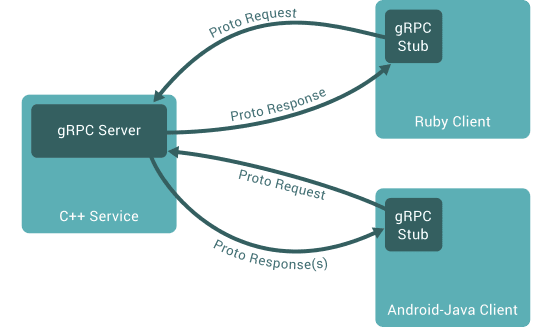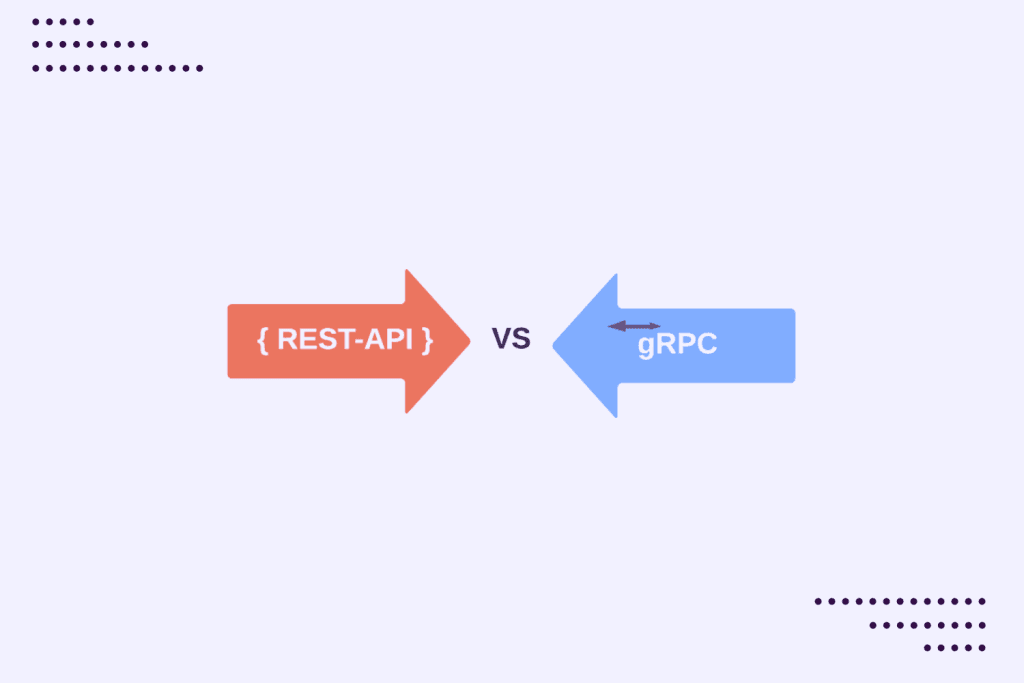gRPC and REST are two ways you can design an API. An API is a mechanism that enables two software components to communicate with each other using a set of definitions and protocols. Building efficient and scalable communication between different components is crucial. One technology that has gained popularity for its speed and flexibility in inter-service communication is gRPC.
What is gRPC?
gRPC, which stands for Remote Procedure Call, is an open-source framework developed by Google. It is a high-performance RPC (Remote Procedure Call) framework that uses the HTTP/2 protocol for communication. Unlike traditional APIs, gRPC allows developers to define service methods and message types using Protocol Buffers, a language-agnostic binary serialization format developed by Google.

Key Features of gRPC:
- Language Agnostic: One of the key advantages of gRPC is its language-agnostic nature. It supports multiple programming languages, including but not limited to C++, Java, Python, Go, and more. This flexibility allows developers to choose the language that best fits their project requirements.
- Protocol Buffers: gRPC uses Protocol Buffers (ProtoBuf) as its interface definition language. ProtoBuf is a language-agnostic binary serialization format that is both efficient and extensible. By defining service methods and message types using ProtoBuf, developers can ensure a consistent and interoperable communication protocol between services.
- Bidirectional Streaming: gRPC supports bidirectional streaming, allowing both the client and server to send a stream of messages to each other. This feature is particularly useful for scenarios where real-time communication is required, such as chat applications or live updates.
- HTTP/2 Protocol: gRPC leverages the HTTP/2 protocol for communication, providing features like multiplexing, header compression, and support for binary data. This results in improved performance compared to traditional REST APIs.
- Code Generation: gRPC facilitates automatic code generation for client and server applications based on the ProtoBuf definitions. This reduces the boilerplate code required for communication, making development more efficient and less error-prone.
How gRPC Works:
- Service Definition: Developers define the service methods and message types using ProtoBuf in a
.protofile. - Code Generation: The gRPC compiler (
protoc) generates client and server code in the desired programming language based on the.protofile. - Server Implementation: Developers implement the server logic, handling the defined service methods.
- Client Implementation: Clients use the generated code to call the server’s methods, simplifying the communication process.
Benefits of gRPC:
- Performance: gRPC’s use of HTTP/2 and binary serialization contributes to improved performance compared to traditional REST APIs.
- Interoperability: Its language-agnostic design allows developers to build services in different languages while maintaining seamless communication.
- Code Generation: Automatic code generation reduces manual effort and ensures consistency between client and server implementations.
- Streaming Support: Bidirectional streaming support enables real-time communication, enhancing the user experience for certain applications.
What is REST?
REST, or Representational State Transfer, is an architectural style for building networked applications. It was introduced by Roy Fielding in his doctoral dissertation in 2000. RESTful systems use standard HTTP methods (such as GET, POST, PUT, and DELETE) to perform operations on resources, which can be anything from documents and images to services and data.
Key Principles of REST
- Statelessness: One of the fundamental principles of REST is statelessness. Each request from a client to a server must contain all the information needed to understand and fulfill that request. The server should not store any information about the client’s state between requests.
- Resource Identification: Resources, the key abstractions in REST, are identified by URIs (Uniform Resource Identifiers). Every resource must have a unique identifier, and clients interact with these resources using standard HTTP methods.
- Representation: Resources can have multiple representations, such as XML, JSON, or HTML. Clients interact with these representations to perform operations on the resources. For example, a client may request a resource in JSON format and later update it using a different representation.
- Stateless Communication: Communication between the client and server is stateless, meaning each request from the client to the server must contain all the information needed to understand and process the request. The server does not store any information about the client’s state between requests.
Common HTTP Methods in REST
- GET: Retrieve information about a resource.
- POST: Create a new resource.
- PUT: Update an existing resource.
- DELETE: Remove a resource.
- PATCH: Apply partial modifications to a resource.
- OPTIONS: Retrieve information about the communication options for a resource.
Benefits of REST
- Simplicity: RESTful APIs are simple and easy to understand, making them widely adopted in web development.
- Scalability: REST allows for scalable systems, as each resource can be accessed independently, and the stateless communication simplifies server management.
- Flexibility: Multiple representations of resources allow clients to choose the format that best suits their needs.
- Compatibility: REST is based on standard HTTP methods, making it compatible with existing web infrastructure.
Summary of differences: gRPC vs. REST
Choosing the right communication protocol for your applications is crucial. Two popular choices that developers often find themselves comparing are gRPC and REST. Each has its strengths and weaknesses, and understanding the differences between them can help you make an informed decision.
| Parameters | gRPC | REST |
| Communication Style | gRPC, developed by Google, is a high-performance RPC (Remote Procedure Call) framework. It uses a binary protocol called Protocol Buffers for serialization and supports multiple programming languages. Unlike REST, gRPC allows for bidirectional streaming and supports various data formats. | REST is an architectural style that relies on a stateless client-server communication model. It uses standard HTTP methods (GET, POST, PUT, DELETE) for operations on resources. Data is typically exchanged in JSON or XML format over HTTP or HTTPS. |
| Data Serialization | gRPC uses Protocol Buffers, a binary serialization format. Protocol Buffers are more efficient in terms of both size and speed compared to JSON. This can result in faster communication between services, making gRPC a preferred choice for high-performance applications. | REST commonly uses JSON or XML for data serialization. While JSON is human-readable and widely supported, it can be less efficient in terms of both size and speed compared to binary formats. |
| Performance | gRPC excels in performance, especially in scenarios involving large amounts of data or high-frequency communication. Its binary serialization and support for bidirectional streaming make it a faster option compared to REST in certain use cases. | REST is generally simpler to implement and is well-suited for simple scenarios. However, as the complexity of the application and the volume of data increase, REST might face performance challenges due to its reliance on text-based formats. |
| Flexibility and Extensibility | gRPC provides more advanced features out of the box, such as bidirectional streaming and support for multiple programming languages. It’s well-suited for complex, distributed systems and supports features like authentication, load balancing, and more. | REST is known for its simplicity and flexibility. It follows a stateless architecture, making it easy to understand and implement. However, this simplicity may limit some advanced features, especially in scenarios requiring real-time updates. |
| Ecosystem and Adoption | While gRPC is gaining popularity, especially in microservices architectures, it may not be as universally adopted as REST. However, major tech companies, including Google, use gRPC extensively in their systems. | REST has been around for a longer time and is widely adopted. There are countless tools and libraries available to work with RESTful APIs. Its simplicity and compatibility make it a popular choice for a wide range of applications. |
Choosing between gRPC and REST depends on the specific requirements of your application. REST is a solid choice for simple applications and scenarios where ease of use and widespread adoption are crucial. On the other hand, gRPC shines in high-performance and complex distributed systems, offering advanced features and efficient communication. Ultimately, the decision should be based on your project’s needs, the desired level of performance, and the ecosystem you’re working in.

